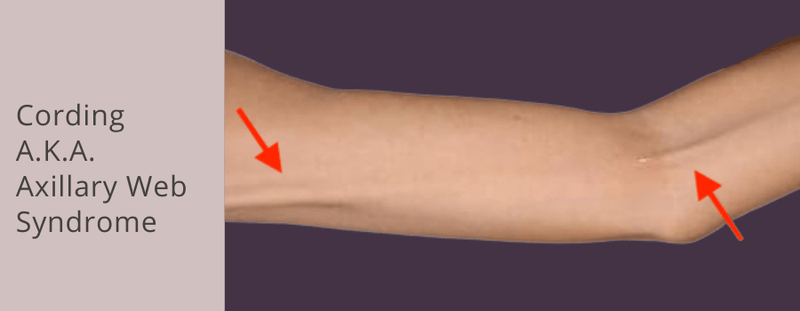

Before I developed lymphedema, I had cording but had no idea what it was. Cording can often a precursor to lymphedema. Denise Stewart, OT, has many years in the game and is an incredible resource. I'm excited to share her awesome guest blog post that I hope will inform many about the what, why and how of cording. I'd highly recommend checking out Denise's website and informative YouTube channel.
Axillary Web Syndrome (AWS), also known as cording, is a tightness of normal tissue within the body. Cording may develop in many women after breast cancer surgery, usually within eight weeks—during the healing phase. Sometimes cording may develop later, during chemotherapy or after radiotherapy. A 2014 review of 37 different studies identified that up to 84% of the women experienced cording after breast cancer surgery.
Initially, the tightness from cording causes significant pain and can inhibit patients from raising their arms or straightening their elbows. The tight tissue is just under the skin and can vary in thickness and presents as:
- thin strings
- rope or cord-like or
- a really thick band of tissue
The thick band which may extend into the armpit has, as yet, not been recognized in research literature as being typical of cording, however matches perfectly to the location and pain experience of the thinner cording experiences.
The tight tissue extends from the breast/chest area into the arm at varying levels:
- to the armpit
- to the upper inside arm
- to the inside elbow
- to the inside wrist or
- at the trunk
The tight tissue is thought to be part of the lymph system, which is normally soft and very stretchy vessels just under the skin. In this area of the body, the lymph system travels from the side of the rib cage across the armpit and then down the inside arm.
Therapists experienced in breast cancer rehabilitation offer a possible explanation as to why cording occurs–breast scar tissue that forms during healing may attach to nearby tissues. Initially scar tissue lacks length and stretch and may adhere to structures such as nearby lymph vessels. This may then result in a corresponding reduction in the amount of stretch at the lymph structures.
Cording assessment relies solely on seeing tightness, feeling tightness and the presence of a common pain experience. The current difficulties that may be faced by women experiencing cording are:
- Cording may not be discussed as a complication by the surgeon
- Some forms of cording may be difficult to see and feel
- Some women do not want to complain about cording to their surgeon
- There may not be recognized comprehensive physical assessment of cording
- Cording assessment may not be a standard practice in breast cancer clinics
- There is very limited research into treatment protocols
- There is low referral to physical rehab therapists and limited numbers of therapists skilled in post-breast cancer care
Because of these factors and the possible higher likelihood of developing cording, it becomes more important for women after breast cancer to be aware of what cording is and how to ask for help to treat cording.
An e-Book Cording-Assessment Guide is now available for purchase. Women are taken through two tests to see whether cording could be the reason for persistent pain or movement recovery problems.


Arm stretches can be commonly prescribed to women during their post-breast cancer recovery. Treatment for cording may require more than arm stretches to manage the degree of tightness within the tissue. Treatments may include: specialized scar tissue massage techniques, low level laser, gentle cupping, stretches and training in self-management techniques.
Treatments and timeframes may vary based on the different thickness in cording (thin or thick). Check out The Cording Protocols Project for timeframes and treatment protocols used by experienced therapists.
Save on Solidea Compression Garments

Disclaimer: This blog is for general information purposes only. Furthermore, information contained in this blog is not a substitute for medical advice – always consult a licensed healthcare professional for advice on your specific condition.



